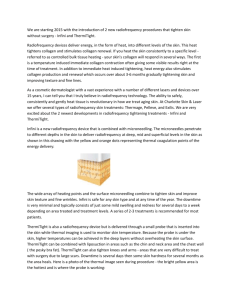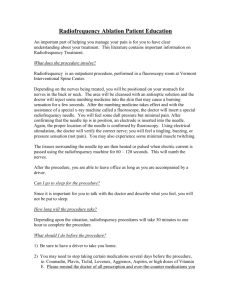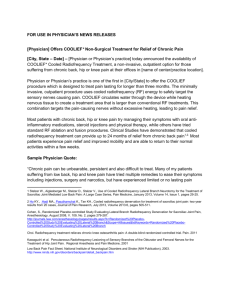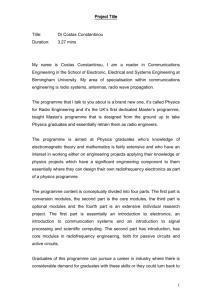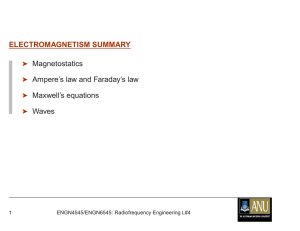Radiofrequency neurotomy for the treatment of chronic pain
advertisement
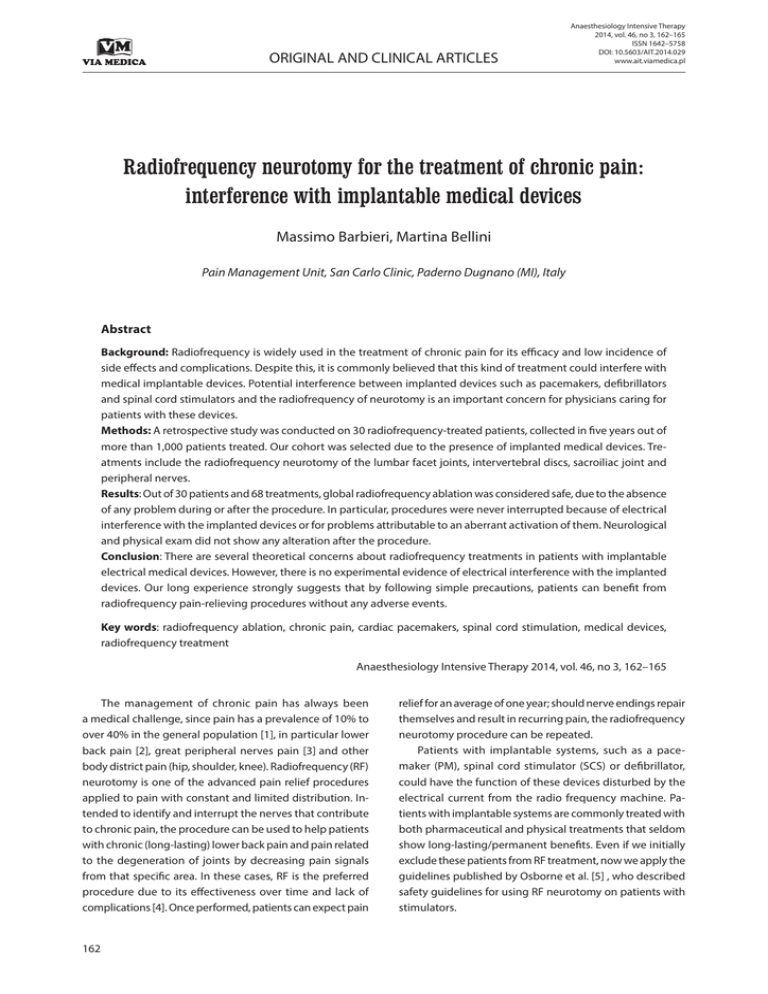
ORIGINAL AND CLINICAL ARTICLES Anaesthesiology Intensive Therapy 2014, vol. 46, no 3, 162–165 ISSN 1642–5758 DOI: 10.5603/AIT.2014.029 www.ait.viamedica.pl Radiofrequency neurotomy for the treatment of chronic pain: interference with implantable medical devices Massimo Barbieri, Martina Bellini Pain Management Unit, San Carlo Clinic, Paderno Dugnano (MI), Italy Abstract Background: Radiofrequency is widely used in the treatment of chronic pain for its efficacy and low incidence of side effects and complications. Despite this, it is commonly believed that this kind of treatment could interfere with medical implantable devices. Potential interference between implanted devices such as pacemakers, defibrillators and spinal cord stimulators and the radiofrequency of neurotomy is an important concern for physicians caring for patients with these devices. Methods: A retrospective study was conducted on 30 radiofrequency-treated patients, collected in five years out of more than 1,000 patients treated. Our cohort was selected due to the presence of implanted medical devices. Treatments include the radiofrequency neurotomy of the lumbar facet joints, intervertebral discs, sacroiliac joint and peripheral nerves. Results: Out of 30 patients and 68 treatments, global radiofrequency ablation was considered safe, due to the absence of any problem during or after the procedure. In particular, procedures were never interrupted because of electrical interference with the implanted devices or for problems attributable to an aberrant activation of them. Neurological and physical exam did not show any alteration after the procedure. Conclusion: There are several theoretical concerns about radiofrequency treatments in patients with implantable electrical medical devices. However, there is no experimental evidence of electrical interference with the implanted devices. Our long experience strongly suggests that by following simple precautions, patients can benefit from radiofrequency pain-relieving procedures without any adverse events. Key words: radiofrequency ablation, chronic pain, cardiac pacemakers, spinal cord stimulation, medical devices, radiofrequency treatment Anaesthesiology Intensive Therapy 2014, vol. 46, no 3, 162–165 The management of chronic pain has always been a medical challenge, since pain has a prevalence of 10% to over 40% in the general population [1], in particular lower back pain [2], great peripheral nerves pain [3] and other body district pain (hip, shoulder, knee). Radiofrequency (RF) neurotomy is one of the advanced pain relief procedures applied to pain with constant and limited distribution. Intended to identify and interrupt the nerves that contribute to chronic pain, the procedure can be used to help patients with chronic (long-lasting) lower back pain and pain related to the degeneration of joints by decreasing pain signals from that specific area. In these cases, RF is the preferred procedure due to its effectiveness over time and lack of complications [4]. Once performed, patients can expect pain 162 relief for an average of one year; should nerve endings repair themselves and result in recurring pain, the radiofrequency neurotomy procedure can be repeated. Patients with implantable systems, such as a pacemaker (PM), spinal cord stimulator (SCS) or defibrillator, could have the function of these devices disturbed by the electrical current from the radio frequency machine. Patients with implantable systems are commonly treated with both pharmaceutical and physical treatments that seldom show long-lasting/permanent benefits. Even if we initially exclude these patients from RF treatment, now we apply the guidelines published by Osborne et al. [5] , who described safety guidelines for using RF neurotomy on patients with stimulators. Martina Bellini, Massimo Barbieri, Implantable medical devices and radiofrequency The aim of the present study was to demonstrate that the simple use of certain precautions allows patients with implantable systems to be treated with the RF technique. lator and pacemaker activity did not suffer any interference; in particular. no aberrant activation of stimulators was detected. METHODS DISCUSSION Our cohort consisted of 30 patients with implantable devices, out of more than 1,000 patients who received radiofrequency neurotomy from December 2008 to December 2012 in one centre. A total of 68 treatments were carried out, with a repetition of 9–11 treatments for patients. Informed consent was obtained after an exhaustive explanation of the radiofrequency procedure, its advantages/disadvantages and its possible contraindications during sensory/motor stimulation due to the presence of an electrical device. Patients were instructed to report any abnormal sensations during the procedure. A pre-surgical evaluation and physical exam were done to detect the electrical devices. Twenty patients had a spinal cord stimulator, five had a pacemaker and five had a defibrillator. Radiofrequency neurotomy was done under local anaesthesia without sedation to avoid any possible reduction of the patient’s ability to report adverse effects. Clinical and technical precautions were introduced in our RF procedure. In patients having spinal cord stimulators, the neurostimulator was checked before and after the procedure by physicians. The following parameters were evaluated: stimulus frequency, pulse duration, intensity of stimulus, interelectrode impedances, and electrode configuration. In patients with cardiac pacemakers, we determined the battery voltage, the lead impedance, the captured thresholds, the sensing thresholds, and the magnet/non-magnet test. In patients with an implantable cardioverter-defibrillator (ICD), an instrumental control was done to verify the integrity of the system ICD, its leads, the interaction between the leads and heart, and the status of the ICD battery, the duration of which varies depending on the number of operations and the operating time of the pacemaker. The patients’ ECGs were monitored before, during, and after the procedure. Moreover we were ready for the quick management of any adverse reactions/interference originating from the RF to electrical devices. In radiofrequency neurotomy, the radio waves are delivered to the targeted nerves via needles inserted through the skin above the spine. Imaging scans are used during radiofrequency neurotomy to help to position the needles. RF is commonly carried out percutaneously and local anaesthesia is sufficient to perform it [6–13]. The procedure can be done by placing an electrode (needle) under continuous X-ray guidance in specific target points and passing a high frequency electrical current through the electrode. Pain relief from RF can last from 6 to 12 months and in some cases relief can last for years [14, 15]. During the painless period, drugs are drastically reduced. More than 70% of patients treated with RF experience pain relief. RF has proven to be a safe and effective way to treat some forms of pain, and it is generally well-tolerated, with very few associated complications. For these reasons, RF is the most common treatment preferred in some forms of pain [16]. The main side effect is some discomfort, including swelling and bruising at the site of the treatment, which generally disappears after a few days. External sources may interfere with the appropriate function of medical devices. Radiofrequency generators produce unmodulated signals with frequencies of between 400 and 500 kHZ. The presence of an electrical device indicates physicians should not proceed with the RF intervention, to avoid patients being exposed to electromagnetic fields [16]; Chin et al. [17] reported generator damage and complete inhibition of pacemakers due to over sensing or pacing-rate increase in dogs. This is an example of potential pacemaker interference from another source of electromagnetic interference. Sun et al. [18] demonstrated a case of percutaneous radiofrequency trigeminal rhizotomy in a patient with a cardiac pacemaker who underwent the procedure without incident. During the postoperative period, the pacemaker was interrogated, and no changes in variables were observed. As such, reprogramming of the pacemaker to its original settings was not necessary. Sluijter et al. [19] recommended a cardiologist consultation to a patient-carried pacemaker to convert the PM to a fixed rate device for the duration of the procedure and that patient-carried spinal cord stimulators in the monopolar mode setting should be changed to bipolar mode. We did not follow these recommendations. Jeon et al. [16] described a case where RF ablation of the third occipital nerve resulted in spontaneous activation of a cervical SCS device. In our study, none of the 30 patient-carried electrical devices showed interference or complications due to the RESULTS The patients’ mean age was 59 years, 22 female: a detailed list of patient characteristics can be found in Table 1. The global result of the procedure was considered very positive due to the absence of any problems during or after the radiofrequency ablation procedure. No adverse reactions were recorded due to electrical interaction or due to clinical events. No differences in neurological or cardiac examination after the treatment were reported. Spinal cord stimulator, implantable cardioverter defibril- 163 Anaesthesiol Intensive Ther 2014, vol. 46, no 3, 162–165 Table 1. Characteristics (sex, age, device implanted) of 30 patient-carried electrical devices Patient Radiofrequency number Sex Age Device type Radiofrequency level Time Kv mA 1 7 F 77 ICD L2-L3,L3-L4,L4-L5, L5-S1 0.25–0.45 73–96 3.5–3.8 2 2 M 67 SCS, PM INTERAPOPHYSEAL JOINTS, OCCIPITAL NERVE 0.04 84 3.7 3 3 F 67 ICD L5-S1 0.27–0.49 77–103 3.6–3.9 4 3 F 47 SCS L5-S1 2.1–4.23 67 3.1 5 4 F 45 SCS D12-L1, L1-L2, L2-L3 1.15 66 2.9 6 1 F 46 SCS SACROILIAC JOINT 0.41 63 2.5 7 11 M 72 ICD L4-L5, L5-S1 1.5–2.1 68–81 3.2–3.6 8 2 F 58 SCS SACROILIAC JOINT 1.26 94 3.8 9 2 F 49 SCS L4-L5 1.24 89 3.5 10 1 F 35 SCS L4-L5 0.40 60 2.6 11 2 F 48 SCS L3-L4, L5-S1 2.3–4,2 78 3.5 12 1 M 59 SCS TORACIC GANGLIA 0.25–0.45 84 3.6 13 1 F 51 SCS SACROILIAC JOINT 0.17 110 4 14 1 F 49 PM SCAROILIAC JOINT 2.7 85 2.4 15 1 F 68 ICD L1-L2, L2-L3, L3-L4, L4L5, L5-S1 1.8 49 1.5 16 1 F 38 SCS L5-S1 3.54 74 3.6 17 2 F 87 PM SOVRASCAPULAR NERVE 2.5 88 2.4 18 3 M 76 SCS L3-L4, L4-L5 0.38–1.15 77–118 3.64 19 4 F 72 SCS L3-L4, L5-S1 4.29 67 3.1 20 2 F 72 PM LUMBAR JOINT, SACROILIAC JOINT 2.3–2.7 81–88 2.8 21 2 M 54 SCS L4-L5 0.01–0.02 66–72 2.9–3.5 22 2 F 58 ICD L2-L3, L3-L4, L4-L5, L5-S1 1.26–1.54 67 3.3–3.8 23 1 M 77 SCS L4-L5 4.2 68 2.5 24 2 F 49 SCS L4-L5, L5-S1 1.5 77 3.5 25 1 F 45 PM SOVRASCAPULAR NERVE 2.2 80 2.7 26 2 F 66 SCS L3-L4 0.10–0.04 53–72 1.0–3.7 27 1 F 40 SCS L5-S1 3.54 74 3.6 28 2 F 66 SCS L5-S1 0.1 55 1.0 29 4 F 72 SCS L5-S1 0.38 86 3.2 30 3 M 54 SCS L5-S1 4.0 50 3.5 electrical field generated during the radiofrequency treatment procedure. In fact, there are no clear reports showing atypical symptoms during RF procedures that would indicate iatrogenic injury of a radiofrequency effect on medical devices. In general, interaction with RF devices would be unusual as long as the current is delivered below the umbilicus, as was the case in all of the patients in our study. The main result of the present study was the positive outcome of radiofrequency treatment in patients suffering chronic pain and carrying medical devices. Commonly, pain 164 therapists work with patient-carried electrical devices, offering alternative interventions to RF to treat their chronic pain, such as steroid injections and physiotherapy, usually with a lower efficacy than RF. In general, patients with medical devices undergoing RF have their device checked before and after the procedure. The potential interactions are asynchronous pacing, inhibition of pacing, pacemaker reset, ventricular pacing up to the Maximum Tracking Rate (MTR) and changes in pacing thresholds. RF applications should be as brief as possible and Martina Bellini, Massimo Barbieri, Implantable medical devices and radiofrequency remote from the pacing electrode tip. Re-interrogation of the device after the procedure is essential and integrity of the circuit should be evaluated. In particular for a pacemaker, rate response function should be turned off. If a patient is not dependent, the pacemaker can be programmed to DDI or VVI at a lower rate than the intrinsic heart rate. If the patient is dependent, the PM should be programmed to VOO or DOO mode and a temporary PM wire should be in place as back-up. ECGs must be monitored before, during and after the procedure. For ICDs, the potential interactions are asynchronous pacing, inhibition of pacing, inappropriate shock therapy, and changes in pacing thresholds. To mitigate the possible interaction, deactivate anti-tachytherapy, programme the device Tachy Mode to ‘off’ and the pacing mode switches to VOO, AOO or DOO. The implantation of spinal cord stimulators is designed to treat chronic intractable pain; RF application could interfere with SCS function, which may result in pain. An RF probe placed too close to the device may generate enough electromagnetic power to interfere with neurostimulator function. To mitigate the possible interaction, the SCS was turned off. Our results suggest that the RF intervention can be safely applied to patients carrying electrical devices, even though there were few ICD and pacemaker patients, so we will extend our cohort. Our long experience in RF allows us to administer safely this easy and long-lasting procedure also to this kind of patient. References: 1. 2. 3. 4. Neville A, Peleg R, Singer Y, Sherf M, Shvartzman P: Chronic pain: a population-based study. Isr Med Assoc J 2008; 10: 676–680. Freburger JK, Holmes GM, Agans RP et al.: The rising prevalence of chronic low back pain. Arch Intern Med 2009; 169: 251–258. Marchettini P, Lacerenza M, Mauri E, Marangoni C: Painful peripheral neuropathies. Curr Neuropharmacol 2006; 4: 175–181. Mikeladze G, Espinal R, Finnegan R, Routon J, Martin D: Pulsed radiofrequency application in treatment of chrnic zygapophyseal joint pain. Spine J 2003; 3: 360–362. 5. 6. 7. 8. 9. 10. 11. 12. 13. 14. 15. 16. 17. 18. 19. Osborne MD: Radiofrequency neurotomy for a patient with deep brain stimulators: proposed safety guidelines. Pain Med 2009; 10: 1046–1049. Hooten WH, Martin DP, Huntoon MA: Radiofrequency Neurotomy for low back pain: evidence based procedural guidelines. Pain Med 2005; 6: 129–138. Kanoplat Y, Savas A, Bekar A, Berk C: Percutaneous controlled radiofrequency trigeminal rhizotomy for the treatment of idiopathic trigeminal neuralgia: 25 year experience with 1,600 patients. Neurosurgery 2001; 48: 524–532. Ercelen O, Bulutcu E, Oktenoglu T et al.: Radiofrequency lesioning using two different time modalities for the treatment of lumbar discogenic pain: a randomized trial. Spine 2003; 28: 1922–1927. Pauza KJ, Howell S, Dreyfuss P, Peloza JH, Dawson K, Bogduk N: A randomized, placebo controlled trial of intradiscal electrothermal therapy for the treatment of discogenic low back pain. Spine J 2004; 4: 27–35. Kornick C, Kramarich SS, Lamer TJ, Stizman BT: Complications of lumbar facet radiofrequency denervation. Spine 2004; 29: 1352–1354. Cohen SP: Sacroiliac joint pain: a comprehensive review of anatomy, diagnosis and treatment. Anesth Analg 2005; 101: 1440–1453. Hansen HC, McKenzie-Brown AM, Cohen SP, Swicegood JR, Colson JD, Manchikanti L: Sacroiliac joint interventions: a systematic review. Pain Physician 2007; 10: 165–184. Rupert MP, Lee M, Manchikanti L, Datta S, Cohen SP: Evaluation of sacroiliac joint interventions: a systematic appraisal of the literature. Pain Physician 2009; 12: 399–418. Kosharskyy B, Rozen D: Feasibility of Spinal Cord Stimulation in a patient with a cardiac pacemaker. Pain Physician 2006; 9: 249–252. Manchikanti L, Datta S, Gupta S et al.: A critical review of the American Pain Society Clinical Practice Guidelines for interventional techniques: Part 2. Therapeutic interventions. Pain Physician 2010; 13: E215–E264. Jeon HY, Shin JW, Kim DH, Leem GJ: Spinal cord stimulator malfunction caused by radiofrequency neuroablation, case report. Korean J Anesthesiol 2010; 59 (Suppl): S226–S228. Sun DA, Martin L, Honey CR: Percutaneous radiofrequency trigeminal rhizotomy in a patient with an implanted cardiac pacemaker. Anesth Analg 2004; 99: 1585–1586. Sluijter M, Racz G: Technical aspects of radiofrequency. Pain Pract 2002; 2: 195–200. Harthorne JW: Pacemakers and store security devices. Cardiol Rev 2001; 9: 10–17. Corresponding author: Martina Bellini, MD Pain Management Unit, San Carlo Clinic Paderno Dugnano (MI), Italy Tel: +39 328 925 3670 e-mail: Bellini_martina@libero.it Received: 15.10.2013 Accepted: 24.03.2014 165
